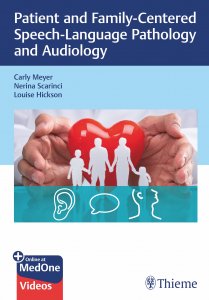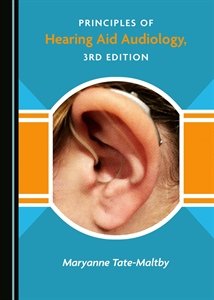Book Review
Meyer C, Scarlinci N, and Hickson L. Patient and Family-Centered Speech-Language Pathology and Audiology.
Thieme Medical Publishers Inc.: New York; 2019.
This book has 158 pages, including the index.
 This soft-covered book is an absolute treasure. Right from the first chapter, with the application of the World Health Organization’s International Classification of Functioning, Disability, and Health (2001) to people living with communication differences, the information presented is evidence-based, integrative, and practical. The evidence-based piece is critical to the strength of the book, and the authors address the erroneous perspective that patient and family-centered care (PFCC) is “air-fairy” (my word, not theirs) in the very beginning of the book.
This soft-covered book is an absolute treasure. Right from the first chapter, with the application of the World Health Organization’s International Classification of Functioning, Disability, and Health (2001) to people living with communication differences, the information presented is evidence-based, integrative, and practical. The evidence-based piece is critical to the strength of the book, and the authors address the erroneous perspective that patient and family-centered care (PFCC) is “air-fairy” (my word, not theirs) in the very beginning of the book.
The book is interactive in the sense that the frequent tools presented throughout, as well as the numerous textboxes of practical suggestions, make the principles of PFCC tangible and implementable. Additionally, readers are encouraged to keep a diary, blog, twitter feed or other records to capture their personal development on the way to becoming clinicians providing PFCC. Scattered throughout the book are snippets of information and advice from a vast array of professionals who share their experiences in a way that makes the reader feel like they are meeting the person over coffee rather than being lectured on how we ought to conduct ourselves and our practices. I really appreciated how the authors acknowledged that they cannot know everything and that being exposed to many different perspectives is a great way for adults to learn. I also found that the information presented throughout encouraged self-reflection and self-awareness, which are critical skills for any clinician to possess.
The book covers preparation and planning for providing PFCC as well as what assessment and management using PFCC entails. The bilateral nature of the clinician-family relationship is reinforced throughout whereby the client and their family are not only an integral part of their own care, but they are partners with the service provider. Focus on the development and improvement of communication and active listening skills of the service provider is also evident.
The final chapter of the book is about consideration of cultural and linguistic diversity in the provision of care. I might argue that in true PFCC, it is not sufficient for the clinician to be responsive to their client/patient’s unique situation, but it is incumbent upon us to provide a standard of care where everyone feels safe, welcomed, respected, and heard.
As is emphasized throughout the book, PFCC is not just a topic for discussion or something that people banter about at professional conferences. It is not about trying to appear open-minded and accepting of everyone. Rather, PFCC actually needs to be infused throughout all aspects of speech-language pathology and audiology practice. This is not simply a question of making our work more relevant, but of making a genuine commitment to actually providing high calibre, respectful biopsychosocial care. This book goes a long way in facilitating the implementation of PFCC within the practices of speech-language pathology and audiology.
I think the only omission of the book is a discussion, or, at the very least, a mention of the implementation of an anti-oppressive framework in the field of medicine generally, but more specifically within the allied health professions of speech-language pathology and audiology. The complexity of oppression and how it is experienced requires deep reflection to comprehend. Unless we acknowledge the very real oppression that exists against people in health care because of race, ethnicity, sexual identity, gender identity or expression, ability/disability, religion, physical appearance, education, intelligence, mental health status, state of wellness, financial status, etc., as well as intersectionality of any number of these traits, we cannot really achieve PFCC. We cannot remedy what do not acknowledge and do not accept. Every one of us is in some way culpable.
The authors state that their intended target audience is S-LP and Audiology students, and some of the recommended activities are geared towards students. The online videos, in particular, would be invaluable for students or beginning clinicians. However, I would encourage all professionals working in the fields of speech-language pathology and audiology to read this book and to genuinely reflect on their own provision of care and what they can do toward moving into providing PFCC.
My hat goes off to the authors. I think their book does a superb job of describing PFCC in the fields of speech pathology and audiology and how this can actually be achieved.
Principles of Hearing Aid Audiology, 3rd Edition,
by Maryanne Tate Maltby, MEd, MSc., EdD
Cambridge Scholars Publishing, 2019, ISBN #978-1-5275-3033-1
www.CambridgeScholars.com
Cost £74.99
 This book, written for a British audience and by a British author, is full of pleasant surprises. When I was first asked to review this book I saw that it was very “British." Some of the approaches and orientation were a bit different from what I expected; some of the standards, although equivalent to North American ANSI/CSA standards, had different code numbers; and some of the caveats may only apply to the British system.
This book, written for a British audience and by a British author, is full of pleasant surprises. When I was first asked to review this book I saw that it was very “British." Some of the approaches and orientation were a bit different from what I expected; some of the standards, although equivalent to North American ANSI/CSA standards, had different code numbers; and some of the caveats may only apply to the British system.
Having said this, despite this book having just over 400 pages, it is quite concise: One can read it cover to cover in a morning. Some parts are “cookbook-like” and other parts tend to provide sufficient background for the reader to go beyond what is simply written on the page.
The level of this book is somewhere between an undergraduate degree and a master’s degree but this should not deter the reader. While it does not have the depth to be a graduate-level textbook, because of its brevity and lack of tangents, it would make a useful reference.
I would suggest that this book be read three times- once before beginning a master’s level program since it provides a nice overview of what is to come; a second time halfway through the audiology student's training; and a third time as the audiology student is about to graduate to demonstrate to the student that they have achieved an appropriate level of knowledge.
Other than its ease of reading, another strength of this book is its breadth. Part one begins with a section on Basic Science- a study of acoustics and speech sciences. The book develops a physical description of the characteristics of speech that is the input to the hearing aid. Parts two and three of the book is about hearing aids and the Audiology and hearing aid clinic. And Part 4 is a nice overview of advanced tests for hearing function.
While parts of the book are perhaps unnecessary (Part 4), the first three parts are a nice summary of the field. This book would be excellent for many undergraduates who are contemplating audiology as a career.

